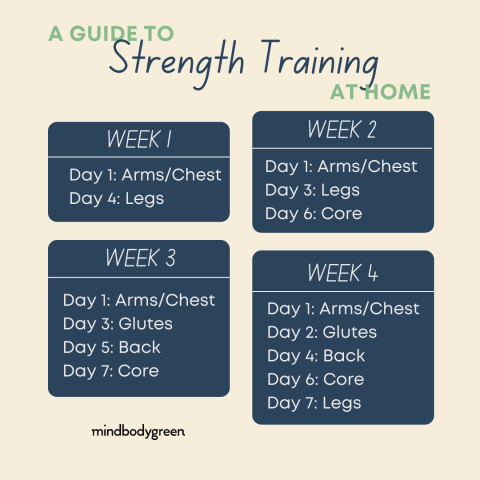Ready to begin your journey to a stronger, even healthier you? Whether you’re brand-new to strength training or only have a little bit of experience from group fitness classes, I’ve created a four-week, easy-to-follow strength training guide for mbg. The goal: I want to help you feel stronger and more confident working with weights. There are many ways to strength train and various types of strength goals. For example, one can train for muscular explosiveness with plyometrics movements or muscular endurance with higher repetitions and lower weights. You can train for hypertrophy (muscle size increase) or ultimate strength (like a powerlifter). All are phenomenal ways to strengthen the body, and depending on your personal goals, you might decide to train more in one or two different ways. For this series, we will be using exercises that feature free weights (also known as dumbbells), as well as bodyweight exercises to focus on hypertrophy. Traditionally, to achieve hypertrophy, trainers suggest an 8- to 12-rep range—that said, recent research suggests you may be able to achieve a hypertrophic goal with a wider variety of rep ranges1. I also encourage you to be fearless, not reckless. Know that your form will probably be off when you’re learning, but it won’t destroy your body—even if you are a little sore in the “wrong” muscles the next day. It’s all part of the learning curve. Do take note, however, if you feel pinching, grinding, or shooting pains (especially in the joints)—take those as signs to make an adjustment ASAP. For this upcoming series, you will need a few sets of dumbbells—kettlebells work well too—of different weights, preferably with more than a few pounds separating them. You’ll also need a sturdy chair or bench and a mat or a soft surface you feel comfortable lying down on. Feel free to do these workouts barefoot (if you feel comfortable doing so)—in fact, I personally recommend going shoeless for lower-body workouts. Another common mistake is sticking with a weight that doesn’t serve you. If you have the ability to try out different loads, please do. I often see someone use the same load for arm and leg exercises. Why is that an issue? Generally most people’s legs can handle more weight than their upper. So if you’re squatting with the same weight as you’re bicep curling, chances are you won’t be challenging your lower body. Always remember that there are more ways to enhance the level of difficulty besides just adding more reps or using heavier dumbbells: Try including a pause at the top of the exercise, add a quarter repetition to each, use more range of motion when appropriate, shorten your rest intervals, etc. With movements that have a large range of motion, like a lunge or a squat, try setting your breath at the top. For example, when performing a squat, inhale, hold the breath, squat down, stand up, exhale. This helps you maintain intra-abdominal pressure, which will help you feel more stable. If this is your very first time working with weights, feel free to progress through the workout plan at a slower pace. Consider each “week” a different “phase” or “stage”: Take two weeks (or more) to continue to the next level. The most important thing is to listen to your body, and progress accordingly. You’ll notice I didn’t specify certain days of the week. That’s because I want this to work for you and your schedule. Slate these workouts any day you see fit—just try to stick to the indicated amount of rest days (for example, in Week 1, there are two days of rest in between the workouts). In addition, here are some workouts that you can also slate in accordingly:



